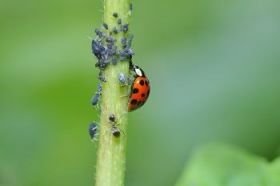Many animals are considered useful to humans because they provide food or other products and have economic value, such as bees that provide honey, wax and pollen.
While others are considered harmful because they cause damage and can even affect human health, such as insects that affect crops or transmit diseases.
Understand more about the true usefulness of animals!
Harmful Why? Useful For Whom?
You invertebrates they are all who have no spine, vertebrae, or skull.
Most of the animals we know are invertebrates: insects, crustaceans, spiders, scorpions, sponges, jellyfish, worms, starfish, among others.
You insects they are the ones with the greatest diversity among all animals. In the following figures, an example of a bed bug (left), which causes skin problems and a termite in detail (right).


Importantly, animals only attack humans when they feel threatened, it is a form of defense. If the human being occupies the territory of an animal, he can attack it to defend its space.
For example, if a person is in the woods and accidentally steps on or touches a spider or scorpion, they are likely to be stung, this is part of the animal's survival instinct. Therefore, it is advisable to know and respect the animal's habits, like any poisonous or poisonous animal, avoiding accidents.
See in the following pictures: a black widow spider (left), details of the eyes of a crab (center) and a scorpion (right).



Read more about venomous spiders that exist in Brazil, in the article about Arachnids.
someone would say, and the parasites?
In fact, the parasites cause harm to their hosts, but most of the time they are not so big that they are worth worrying about.
They are usually already well adapted to each other, if the host dies the parasite will die and thus the tendency is for this relationship to become balanced across generations, producing a relationship called coadaptation.
After all, a person is not likely to die from having lice in their head, and there are many ways to eliminate them.
 Photo of a tapeworm in the human intestine.
Photo of a tapeworm in the human intestine.
Among the parasites of the human being, we highlight the lice, grubs and worms flatworms (tapeworms and schistosomes) and nematodes or roundworms (worms, hookworms, geographic bugs, among others).
Other invertebrates can transmit diseases that deserve real care, as in the case of the mosquito of dengue.
Also read about diseases: schistosomiasis, scabies or scabies and malaria.
Animals are Very Useful in Nature
On the other hand, all animals are useful if we think about food chains. Even those said to be harmful, the most repugnant insect considered harmful to human beings can be the precious food of a bird, or a frog.
If it is exterminated so as not to affect man, it will harm those who feed on it and so on, it will end up affecting the entire balance of nature.
One example is that of the ladybird and aphids, they attack plants and are considered harmful, but in nature they are food for the ladybird. That's right, the ladybug is carnivorous and a predator of aphid herbivores! (See the photo on the left, and on the right the aphids in detail on the plant.)


In the food webs, the human species is at the top, so we are the predators!
Many animals (both invertebrates and vertebrates) that are classified as useful because they serve as food or provide products appreciated by human beings have already suffered or suffer from mistreatment, some are threatened with extinction and others have already been extinct.
Read more about endangered animals in Brazil.
The Risks to the Ecological Balance
It is important to reflect on the classifications of animals as useful or harmful, understanding that with this there may be wrong notions about a "harmful" animal and excessive valuation and consequent exploitation of the "useful", promoting prejudices about certain animals and risks for others.


In addition to deforestation and habitat destruction, illegal hunting and animal trafficking, environmental crimes continue to happen indiscriminately, disrespecting the natural balance and threatening many species.
An example of this problem are some species of crab spiders, which are neither aggressive nor venomous and highly appreciated in Europe as pets.
There are 2 species at risk of extinction found in Bahia, one to gamba poultry house is classified in critical situation. already the Avicularia diversipes (picture above left) is in danger (according to 2014 data from the Ministry of the Environment and ICMBio), and they are endemic to Brazil, that is, they only exist here.
While in nature there is no classification or distinction, there are relationships between species that allow a balance, which is often damaged by human action.



